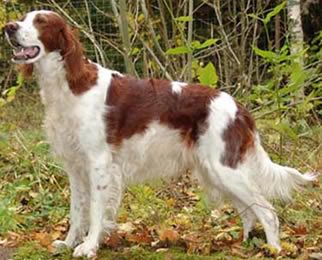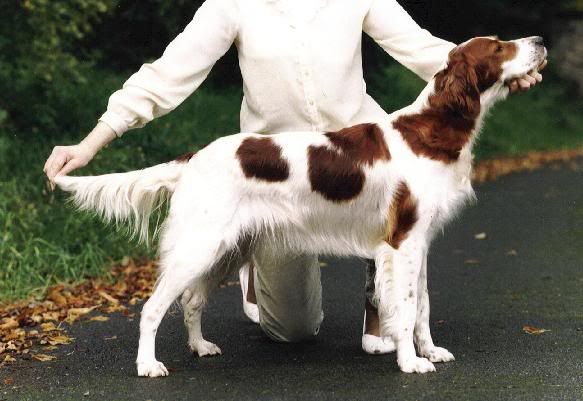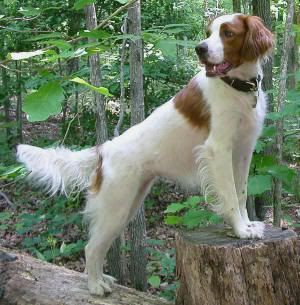Post by DogGoneGood on Sept 28, 2008 17:27:32 GMT -5
Group: 1 - Sporting
Origin: Ireland
Purpose: Bird Setting & Retrieving

General Appearance: Strong and powerful, well balanced and proportioned without lumber; athletic rather than racy.
Size: Desirable height at withers:
Dogs: 24 1/2 inches to 26 inches (62 to 66 cm.)
Bitches: 22 1/2 inches to 24 inches (57 to 61 cm.)
Tail: Moderate length, not reaching below hock, strong at root, tapering to a fine point; no appearance of ropiness and carried level with or below the back.
Head: Broad in proportion to the body. Skull: domed without showing occipital protuberance, as in the Irish Red Setter. Stop: good stop. Muzzle: clean and square. Jaws: of equal or nearly equal length. Teeth: regular, scissors bite ideal; level bite acceptable. Eyes: dark hazel or dark brown; round, with slight prominence and without haw. Ears: set level with the eyes, and well back, lying close to the head.
Neck: Moderately long, very muscular, but not too thick, slightly arched, free from all tendency to throatiness.
Forequarters: Forelegs straight and sinewy, well boned. Shoulders well laid back. Elbows free, turning neither in nor out. Pastern strong.
Hindquarters: Wide and powerful; hind legs from hip to hock long and muscular, from hock to heel of moderate length and strong. Stifle well bent. Hock well let down, turning neither in nor out. Feet close knit with plenty of feathering between toes.
Body: Strong and muscular. Back very muscular and powerful. Chest, deep with well sprung ribs.

Gait: When moving at the trot long striding, very lively, graceful and efficient. Head held high, hindquarters drive smoothly and with great power. Forelegs reach well ahead and remain low. Seen from front or rear forelegs and hind legs below the hock joint moving perpendicularly to the ground; no crossing or weaving of legs, front or back.
Coat and Colour: Hair: long, silky, fine hair called 'feathering' on the back of the fore and hind legs and on the outer ear flap, also a reasonable amount on the flank extending on to the chest and throat forming a fringe. All feathering straight, flat and not over profuse. The tail should be well feathered. On the head, front of legs and other parts of the body the hair should be short, flat and free from curl but slight wave is permissible.
Base colour white with solid red patches (clear islands of red colour), both colours should show the maximum of life and bloom; flecking but not roaning permitted around the face and feet and up the foreleg as far as the hock; roaning, flecking and mottling on any other part of the body is most objectionable and is to be heavily penalized.
Temperment: Aristocratic, keen and intelligent. Displays a kindly, friendly attitude, behind which should be discernible determination, courage and high spirit.
Faults: Any departure from the foregoing points should be considered a fault and the seriousness with which the fault should be regarded should be in exact proportion to its degree.
NB: Male animals should have two apparently normal testicles fully descended into the scrotum.
History: The Irish Setter probably came to its own at the end of the 17th century. It is not well known outside of Ireland that there are two breeds of Irish Setters, but it is fairly certain, that the Red and White Setter is the older of the two, and that judicious selective breeding evolved the solid red colour. When the Irish Setters came to the show benches, just past the middle of the 19th century, there was a good deal of confusion about their proper colour. By the end of the 19th century, the Red Setter had virtually eclipsed the Red and White, which became so rare, that they were thought to be extinct. During the 1920's efforts were made to revive the breed.
By 1944, the breed had re-established itself well enough to have a club of its own, and today it can be seen in healthy numbers at Irish shows. To hunters it has been considered slightly superior to the Red Setter because of its calmer temperament, and because it can be more easily seen in the autumn countryside. The Irish Red and White Setter is bred primarily for the field. All judges must be encouraged to judge the dogs from the working standpoint.

Sources:
Irish Red & White Setter Club of Canada
Origin: Ireland
Purpose: Bird Setting & Retrieving

General Appearance: Strong and powerful, well balanced and proportioned without lumber; athletic rather than racy.
Size: Desirable height at withers:
Dogs: 24 1/2 inches to 26 inches (62 to 66 cm.)
Bitches: 22 1/2 inches to 24 inches (57 to 61 cm.)
Tail: Moderate length, not reaching below hock, strong at root, tapering to a fine point; no appearance of ropiness and carried level with or below the back.
Head: Broad in proportion to the body. Skull: domed without showing occipital protuberance, as in the Irish Red Setter. Stop: good stop. Muzzle: clean and square. Jaws: of equal or nearly equal length. Teeth: regular, scissors bite ideal; level bite acceptable. Eyes: dark hazel or dark brown; round, with slight prominence and without haw. Ears: set level with the eyes, and well back, lying close to the head.
Neck: Moderately long, very muscular, but not too thick, slightly arched, free from all tendency to throatiness.
Forequarters: Forelegs straight and sinewy, well boned. Shoulders well laid back. Elbows free, turning neither in nor out. Pastern strong.
Hindquarters: Wide and powerful; hind legs from hip to hock long and muscular, from hock to heel of moderate length and strong. Stifle well bent. Hock well let down, turning neither in nor out. Feet close knit with plenty of feathering between toes.
Body: Strong and muscular. Back very muscular and powerful. Chest, deep with well sprung ribs.

Gait: When moving at the trot long striding, very lively, graceful and efficient. Head held high, hindquarters drive smoothly and with great power. Forelegs reach well ahead and remain low. Seen from front or rear forelegs and hind legs below the hock joint moving perpendicularly to the ground; no crossing or weaving of legs, front or back.
Coat and Colour: Hair: long, silky, fine hair called 'feathering' on the back of the fore and hind legs and on the outer ear flap, also a reasonable amount on the flank extending on to the chest and throat forming a fringe. All feathering straight, flat and not over profuse. The tail should be well feathered. On the head, front of legs and other parts of the body the hair should be short, flat and free from curl but slight wave is permissible.
Base colour white with solid red patches (clear islands of red colour), both colours should show the maximum of life and bloom; flecking but not roaning permitted around the face and feet and up the foreleg as far as the hock; roaning, flecking and mottling on any other part of the body is most objectionable and is to be heavily penalized.
Temperment: Aristocratic, keen and intelligent. Displays a kindly, friendly attitude, behind which should be discernible determination, courage and high spirit.
Faults: Any departure from the foregoing points should be considered a fault and the seriousness with which the fault should be regarded should be in exact proportion to its degree.
NB: Male animals should have two apparently normal testicles fully descended into the scrotum.
History: The Irish Setter probably came to its own at the end of the 17th century. It is not well known outside of Ireland that there are two breeds of Irish Setters, but it is fairly certain, that the Red and White Setter is the older of the two, and that judicious selective breeding evolved the solid red colour. When the Irish Setters came to the show benches, just past the middle of the 19th century, there was a good deal of confusion about their proper colour. By the end of the 19th century, the Red Setter had virtually eclipsed the Red and White, which became so rare, that they were thought to be extinct. During the 1920's efforts were made to revive the breed.
By 1944, the breed had re-established itself well enough to have a club of its own, and today it can be seen in healthy numbers at Irish shows. To hunters it has been considered slightly superior to the Red Setter because of its calmer temperament, and because it can be more easily seen in the autumn countryside. The Irish Red and White Setter is bred primarily for the field. All judges must be encouraged to judge the dogs from the working standpoint.

Sources:
Irish Red & White Setter Club of Canada

